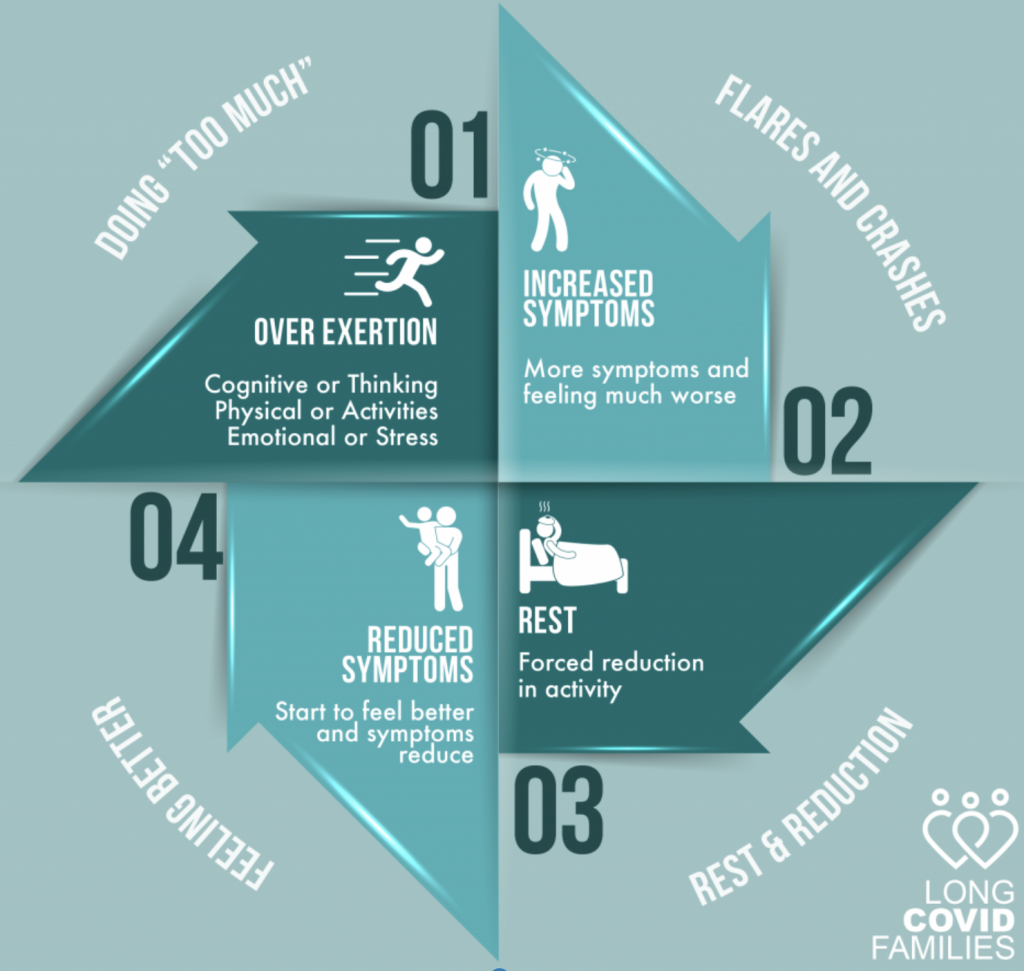
Low Stamina / Fatigue
There are ways to manage exhaustion, fatigue, low stamina & post exertional malaise. The following is a collection of strategies used by the patient community. As always, please consult your doctor before making any lifestyle changes.
Fatigue is the most common symptom reported by those Long Haulers. It is important to understand that for most this is much more than “just feeling tired.”
“I can barely put one foot in front of the other, barely lift my arm.”
– The Voice of the Patient – From the CDC
What is PEM?
Post Exertional Malaise, or PEM, can be triggered after daily activities: a shower, a phone call, or a walk around the block. Everyones threshold is different and can vary.
The PEM “crash” can feel like the flu, an increase in neurological symptoms, gastrointestinal symptoms, headaches, sensory sensitivity, or crushing fatigue.
PEM symptoms are usually delayed. Onset is a worsening symptoms, usually delayed by hours or days.
*** WARNING ***
The crash can persist for hours, days, weeks, or permanently.
Exercise intolerance observed in Long COVID is not physical deconditioning. There is important differences in physiological responses to acute exercise between people with deconditioning compared to people with PEM.
Physiological differences
Physiological differences in Long Haulers experiencing PEM can be measured with Cardiopulmonary Stress Testing, or CPET. In November 2021, Use of Cardiopulmonary Stress Testing for Patients With Unexplained Dyspnea Post–Coronavirus Disease, identified abnormal findings in: circulatory impairment, abnormal ventilatory pattern, dysfunctional breathing, and resting hypocapnia.

Graded Exercise Therapy (GET)
Graded exercise therapy, or GET, is a form of physical therapy where physical activity is gradually increased over time, regardless of how the patient is feeling and ignoring any increased symptoms or new symptoms.
GET is also known as Graded Activity Management (GAM), and Graded Activity Therapy (GAT).
HARMFUL TO THE MAJORITY
“GET was offered as a primary treatment for ME/CFS to UK patients by the National Health Service (NHS), as specified in the NICE guidelines from 2007-2021, but the GET recommendation was removed by the 2021 NICE guidelines update because of high rates of harm.”
– MEPedia
“Crash” Cycles

A study published in April 2021 found that 89.1% of those with Long Covid experience Post Exertional Malaise, or PEM. This is a worsening of symptoms after activities. These can be physical, mental, or emotional stimulus.
The following cycles are seen:
- Person does “too much” of an activity.
- They experience a “flare” of symptoms, or body “crash,” sometimes immediate, sometimes delayed up to 48 hours.
- The crash forces them to rest & reduce activity.
- They start to recover.
WARNING
Many people who experience PEM report experiencing specific events (walking to the store) and “crashes or flares” (worsening of symptoms) that they have never fully recovered from. We cannot stress enough – activity and symptom tracking will help you learn your personal limits and triggers.
“More than 3 decades of trying exercise in this population [post-viral illness] can be summed up in one sentence: Exercise can be harmful, sometimes life threatening, and should be avoided.”
Learn your limits
Everyone’s threshold for what their body can do is different. Here are some *very general* do’s and don’ts for Post Exertional Malaise.
Most importantly respect your body and your own personal limits.
PEM Do’s
Stop before you’re tired
Monitor your heart rate
Laying or floor exercise
Strengthening exercises
Stretches
Aqua therapy
Conserve energy
Prioritize tasks
Use mobility aids
Take breaks
PEM Don’ts
Push your limits
“Power through”
Intense cardio workouts
Ignoring your body
Busy or loud environments
Stressful situations
Long days
Survive a Crash
Hydrate
Lay down
Dark & quiet room
Weighted blanket
Take a nap
Take it easy
Minimize all activity
Methods for preventing PEM / “The Crash”

Energy Envelope
The energy envelope theory explains that all people have a limited amount of energy available to them each day. The amount of energy they have is called represented by their energy envelope.

The Spoon Theory
“The Spoon Theory” was created by Christine Miserandino to describe the idea of having a limited amount of energy, using “spoons” as a unit of energy.

Stop. Rest. Pace.
MEaction.org
The people of MEAction have a message for Long Haulers:
Stop, Rest, Pace. They also offer a very useful pacing guide.

Pediatric Pacing Guide
Pacing is an activity management strategy to avoid post-exertion malaise (PEM). We developed this guide in collaboration with MEAction.
Research on Pacing & PEM in Long Haulers:
Long Covid Families continually adds to our collection of research and resources via AirTable.
Published: February 2, 2022
Lessons from Myalgic Encephalomyelitis/Chronic Fatigue Syndrome for Long COVID: Postexertional Symptom Exacerbation is an Abnormal Response to Exercise/Activity
Published: April 30, 2021
Humility and Acceptance: Working Within Our Limits With Long COVID and Myalgic Encephalomyelitis/Chronic Fatigue Syndrome
Published: April 05, 2021
Characterizing Long COVID in an International Cohort: 7 Months of Symptoms and Their Impact
COMMUNITY SUPPORT
Long Covid Families is happy to support the community in any way we can. Join our Facebook Support Group, follow us on social media, or contact us, anytime.
SUPPORT THE CAUSE
Donations are tax deducible and every little bit helps us pay for the essential tools we use for advocacy & awareness. Donate to Long Covid Families.

